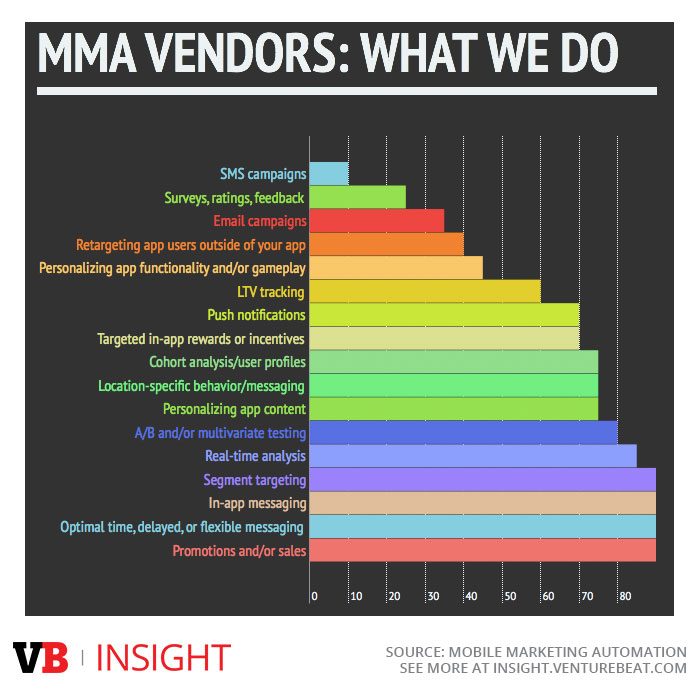The world of mobile marketing automation (MMA) can be a scary one. MMA is how big enterprises and “triple-A” app developers get you to spend more money with them.
But MMA solutions aren’t just for those with mega budgets.
Within the pages of his most recent report — a 20,000-word deep-dive into the MMA industry — VB Insight analyst John Koetsier has uncovered the most important information of all: How the technology will make you more money, even if you’re a small fish in a big pond. The report is based on the experiences of 375 mobile developers with over 900 million monthly users, and a deep dive into the technology inside 1.8 million iOS and Android apps.
Before we dig into how MMA solutions help you monetize your users, it is important to explain the vendors that are involved in the industry and what MMA is used for.
The players
The MMA industry, according to Koetsier, is set to double in size (at least) in 2015.
“First you have the innovators and instigators, like Appboy, Leanplum, Kahuna, Swrve, and Nudge, who are native mobile marketing automation platforms,” Koetsier, VP of research at VB Insight, told me. “These products are almost CRM tools.”
Of course, MMA has created enough ripples that many of the huge marketing cloud companies are getting in on the act.
“Marketing giants like Salesforce and Adobe, and to a very small extent IBM, have discovered that mobile really, really matters,” Koetsier said. “They know they need solutions for user acquisition, engagement, and monetization if they’re going to have a complete mobile-also marketing cloud.”
Mobile Marketing Automation:
How the most successful apps drive massive engagement and monetization
is now available on VB Insight
Who else is involved?
“Then you have the ‘let’s-do-that-too’ firms, who are into mobile analytics or mobile advertising and see the opportunity to put together an entire suite for mobile publishers,” Koetsier said. “Those include Tapjoy, Upsight, and — to an extent — DeltaDNA.”
The one anomaly in the report is Urban Airship.
It in a very real sense founded this space years ago with mobile messaging capabilities and has a large client list, but has only very recently added some of the more fundamental marketing automation features.
So that’s the current landscape, and Koetsier’s report on mobile marketing automation solutions goes into incredible detail on each of those 21 vendors. But how does MMA actually work?
The game
Take a pinch of traditional marketing automation, with the ability to segment prospects and customers, understand their interactions with you, and provide ways to engage with them. Then, add in a scoop of traditional app analytics, focusing on the number of visitors, installs, sessions, usage, and behavior.
Now, mix it all up, and you have something approaching MMA.
“It is about deeply understanding known and unknown users. Engaging with them. And, of course, monetizing them,” Koetsier said.
“Enterprises like Starbucks and Alaska Airlines use MMA. So do Walgreens and Macy’s. Apps and games such as Plants vs. Zombies, Rivals at War, and even Talking Tom Cat use MMA,” Koetsier said.
But if you think these solutions are only for those with massive marketing budgets, think again. Some of the current mobile marketing automation solutions start as low as $100 per month.
And the return on that investment can be significant. I asked Koetsier which case study piqued his interest the most while doing the dozens of interviews needed for the report .
The payoff
“Appboy CEO Mark Ghermezian told me that one client made $100,000 of new revenue with a single in-app message,” Koetsier said. “They did this through smart targeting, and by finding a potentially rich segment.”
Who else did a good job?
“With Salesforce, client Snag-a-Job uses their mobile marketing automation tools to send out a morning email with new opportunities,” Koetsier said. “If — and only if — recipients have not viewed and responded, the company follows up with a push reminder on mobile. It is an omnichannel approach to user engagement, and it pays off.”
MMA solutions aren’t yet the omnichannel be-all-and-end-all you’d hope for — many are still young, fresh startups. While most do a great job with analytics and in-app messaging, a few still lack email, SMS, and survey functionality.
“Email is hard because you need to know your user very intimately to get it,” Koetsier said. “SMS is hard because it comes with a cost attached. And survey tools just seem to have slipped under the radar.”
It is clear, however, that these 21 products are helping many organizations understand, engage with, and monetize mobile-using prospects and existing customers.
Leading the charge against the massive marketing clouds, according to Koetsier’s research? Appboy and Kahuna.
“They offer real-time API-level access right into their data, so what a customer is doing is always knowable. In other words, if someone buys something on your iPad app, you know that, and your website reflects the fact, and your email marketing newsletter knows about it too, and on their next trip to the store, the cashier does as well,” Koetsier said.
“Mobile Marketing Automation: How the most successful apps drive massive engagement & monetization” is available now at VB Insight.
VentureBeat's mission is to be a digital town square for technical decision-makers to gain knowledge about transformative enterprise technology and transact. Learn More



